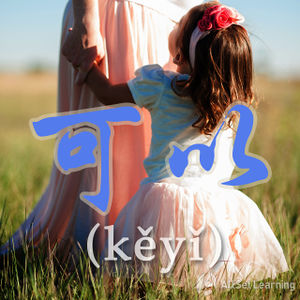Difference between revisions of "Expressing permission with "keyi""
m |
m (Text replacement - "gàosù" to "gàosu") |
||
| Line 21: | Line 21: | ||
<div class="liju"> | <div class="liju"> | ||
| − | * 你 <em>可以</em> 告诉 他。<span class="pinyin">Nǐ <em>kěyǐ</em> | + | * 你 <em>可以</em> 告诉 他。<span class="pinyin">Nǐ <em>kěyǐ</em> gàosu tā.</span><span class="trans">You can tell him.</span> |
* 我 <em>可以</em> 看 这 个 吗?<span class="pinyin">Wǒ <em>kěyǐ</em> kàn zhè gè ma?</span><span class="trans">May I see this?</span> | * 我 <em>可以</em> 看 这 个 吗?<span class="pinyin">Wǒ <em>kěyǐ</em> kàn zhè gè ma?</span><span class="trans">May I see this?</span> | ||
* 他 <em>可以</em> 跟 我们 来。<span class="pinyin">Tā <em>kěyǐ</em> gēn wǒmen lái.</span><span class="trans">He can come with us.</span> | * 他 <em>可以</em> 跟 我们 来。<span class="pinyin">Tā <em>kěyǐ</em> gēn wǒmen lái.</span><span class="trans">He can come with us.</span> | ||
| Line 50: | Line 50: | ||
<div class="liju"> | <div class="liju"> | ||
| − | * 你 <em>不 可以</em> 告诉 他。<span class="pinyin">Nǐ <em>bù kěyǐ</em> | + | * 你 <em>不 可以</em> 告诉 他。<span class="pinyin">Nǐ <em>bù kěyǐ</em> gàosu tā.</span><span class="trans"> You can't tell him.</span> |
* 小孩子 <em>不 可以</em> 看 这 个。<span class="pinyin">Xiǎo háizi <em>bù kěyǐ</em> kàn zhè gè.</span><span class="trans">Young children can't watch this.</span> | * 小孩子 <em>不 可以</em> 看 这 个。<span class="pinyin">Xiǎo háizi <em>bù kěyǐ</em> kàn zhè gè.</span><span class="trans">Young children can't watch this.</span> | ||
* 他 <em>不 可以</em> 跟 我们 来。<span class="pinyin">Tā <em>bù kěyǐ</em> gēn wǒmen lái.</span><span class="trans">He can't come with us.</span> | * 他 <em>不 可以</em> 跟 我们 来。<span class="pinyin">Tā <em>bù kěyǐ</em> gēn wǒmen lái.</span><span class="trans">He can't come with us.</span> | ||
Revision as of 09:02, 11 August 2015
-
Level
-
Similar to
-
Used for
-
Keywords
可以 (kěyǐ) is an auxiliary verb primarily used for expressing permission. It's often translated as "can," but in order to not get it confused with other words, it's best to think of it as "may" to emphasize the permission aspect.
Contents
Basic Usage
Just put 可以 (kěyǐ) in directly before a verb to create a meaning of "may" (plus the verb). It's the same structure whether it's a statement or a question.
Structure
Subject + 可以 + Verb + Object
Use this structure to express permission to do things.
Examples
- 你 可以 告诉 他。You can tell him.
- 我 可以 看 这 个 吗?May I see this?
- 他 可以 跟 我们 来。He can come with us.
- 我 可以 进来 吗?May I come in?
- 你 可以 十 点 来 吗?Can you come at 10 o'clock?
- 十 八 岁 以后 可以 喝 酒。After you are 18 years old you may drink alcohol.
- 我 可以 要 两 个 吗?Can I have two?
- 妈妈,我 可以 出去 玩 吗?Mom, may I go out and have fun?
- 现在 可以 吃 饭 吗?Can we eat now?
- 这里 可以 说话 吗?Can I speak here?
Negating 可以 sentences
可以 (kěyǐ) sentences are negated with 不 (bù), which is inserted before 可以 (kěyǐ).
Structure
Subject + 不 + 可以 + Verb + Object
Examples
- 你 不 可以 告诉 他。 You can't tell him.
- 小孩子 不 可以 看 这 个。Young children can't watch this.
- 他 不 可以 跟 我们 来。He can't come with us.
- 现在 你 不 可以 进来。You can't come in right now.
- 你 不 可以 迟到。You can't be late.
- 十 八 岁 以前 不 可以 喝 酒。Before you are 18 you can't drink alcohol.
- 我 不 可以 要 两 个 吗?Can't I have two?
- 妈妈,我 不 可以 出去 玩 吗?Mom, can't I go out and have fun?
- 现在 不 可以 吃 饭 吗?Can't I eat now?
- 这里 不 可以 说话 吗?Can't I talk here?
See also
- Expressing ability or possibility
- Comparing "hui" "neng" "keyi"
- Expressing a learned skill with "hui"



